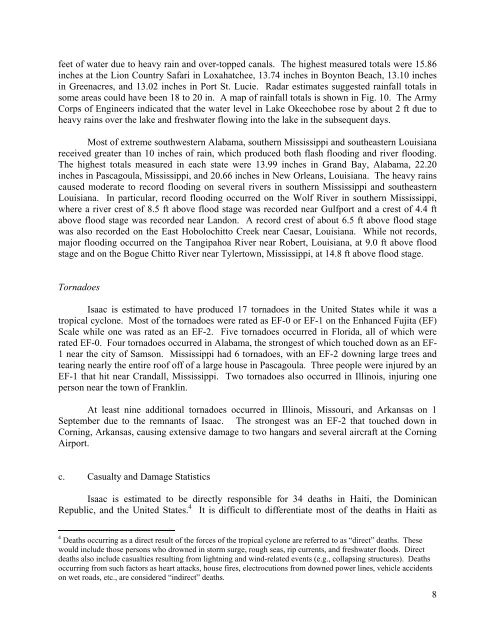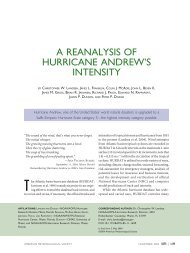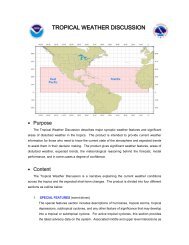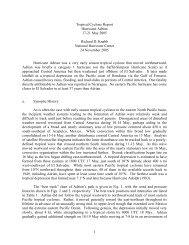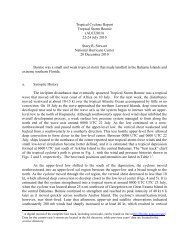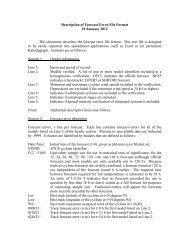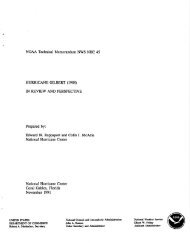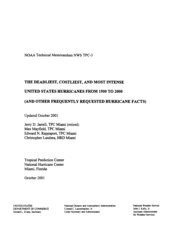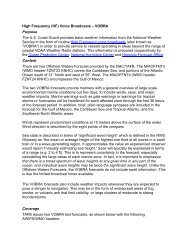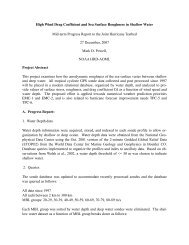Tropical Cyclone Report - National Hurricane Center - NOAA
Tropical Cyclone Report - National Hurricane Center - NOAA
Tropical Cyclone Report - National Hurricane Center - NOAA
Create successful ePaper yourself
Turn your PDF publications into a flip-book with our unique Google optimized e-Paper software.
feet of water due to heavy rain and over-topped canals. The highest measured totals were 15.86<br />
inches at the Lion Country Safari in Loxahatchee, 13.74 inches in Boynton Beach, 13.10 inches<br />
in Greenacres, and 13.02 inches in Port St. Lucie. Radar estimates suggested rainfall totals in<br />
some areas could have been 18 to 20 in. A map of rainfall totals is shown in Fig. 10. The Army<br />
Corps of Engineers indicated that the water level in Lake Okeechobee rose by about 2 ft due to<br />
heavy rains over the lake and freshwater flowing into the lake in the subsequent days.<br />
Most of extreme southwestern Alabama, southern Mississippi and southeastern Louisiana<br />
received greater than 10 inches of rain, which produced both flash flooding and river flooding.<br />
The highest totals measured in each state were 13.99 inches in Grand Bay, Alabama, 22.20<br />
inches in Pascagoula, Mississippi, and 20.66 inches in New Orleans, Louisiana. The heavy rains<br />
caused moderate to record flooding on several rivers in southern Mississippi and southeastern<br />
Louisiana. In particular, record flooding occurred on the Wolf River in southern Mississippi,<br />
where a river crest of 8.5 ft above flood stage was recorded near Gulfport and a crest of 4.4 ft<br />
above flood stage was recorded near Landon. A record crest of about 6.5 ft above flood stage<br />
was also recorded on the East Hobolochitto Creek near Caesar, Louisiana. While not records,<br />
major flooding occurred on the Tangipahoa River near Robert, Louisiana, at 9.0 ft above flood<br />
stage and on the Bogue Chitto River near Tylertown, Mississippi, at 14.8 ft above flood stage.<br />
Tornadoes<br />
Isaac is estimated to have produced 17 tornadoes in the United States while it was a<br />
tropical cyclone. Most of the tornadoes were rated as EF-0 or EF-1 on the Enhanced Fujita (EF)<br />
Scale while one was rated as an EF-2. Five tornadoes occurred in Florida, all of which were<br />
rated EF-0. Four tornadoes occurred in Alabama, the strongest of which touched down as an EF-<br />
1 near the city of Samson. Mississippi had 6 tornadoes, with an EF-2 downing large trees and<br />
tearing nearly the entire roof off of a large house in Pascagoula. Three people were injured by an<br />
EF-1 that hit near Crandall, Mississippi. Two tornadoes also occurred in Illinois, injuring one<br />
person near the town of Franklin.<br />
At least nine additional tornadoes occurred in Illinois, Missouri, and Arkansas on 1<br />
September due to the remnants of Isaac. The strongest was an EF-2 that touched down in<br />
Corning, Arkansas, causing extensive damage to two hangars and several aircraft at the Corning<br />
Airport.<br />
c. Casualty and Damage Statistics<br />
Isaac is estimated to be directly responsible for 34 deaths in Haiti, the Dominican<br />
Republic, and the United States. 4 It is difficult to differentiate most of the deaths in Haiti as<br />
4 Deaths occurring as a direct result of the forces of the tropical cyclone are referred to as “direct” deaths. These<br />
would include those persons who drowned in storm surge, rough seas, rip currents, and freshwater floods. Direct<br />
deaths also include casualties resulting from lightning and wind-related events (e.g., collapsing structures). Deaths<br />
occurring from such factors as heart attacks, house fires, electrocutions from downed power lines, vehicle accidents<br />
on wet roads, etc., are considered “indirect” deaths.<br />
8


